The Shape of Time
The Shape of Time: Chronology and Connoisseurship
The Greek vases displayed in this case once served practical purposes as ornate containers for food or drink. Buried for thousands of years, they now provide clues to life in the ancient Mediterranean world. Through careful observation, scholars have identified unnamed individual painters based on stylistic differences and gleaned valuable historical and cultural information from vessels such as these. This process—known as connoisseurship—transformed long-forgotten objects into some of the most studied forms in Western art, appreciated by historians, artists, poets, and museumgoers alike.
These vases also demonstrate a major technological and stylistic change. Three of the vessels were decorated using what is known as the black-figure painting technique: artists painted the figures in a slip that turned dark when fired in a kiln, while the unglazed clay took on a vivid orange hue. The three later vessels are examples of red-figure painting, in which the artists applied dark-firing slip to the space around the figures, leaving room in the orange expanses to apply fine detail.
As suggested by the fish plate, changes in technique and style accompanied cultural shifts. Scenes of everyday life—enlivened with the red-figure technique’s expressive lines—increasingly replaced divine and heroic themes as popular decorations for these functional items.
Black-Figure Eye Cup
Attributed to the Group of Walters 48.42
Greece, Attica, c. 510 BCE
Terracotta
Purchase with funds provided by the Christian A. Johnson Memorial Art Acquisition Fund and the Memorial Art Fund, 2012.001
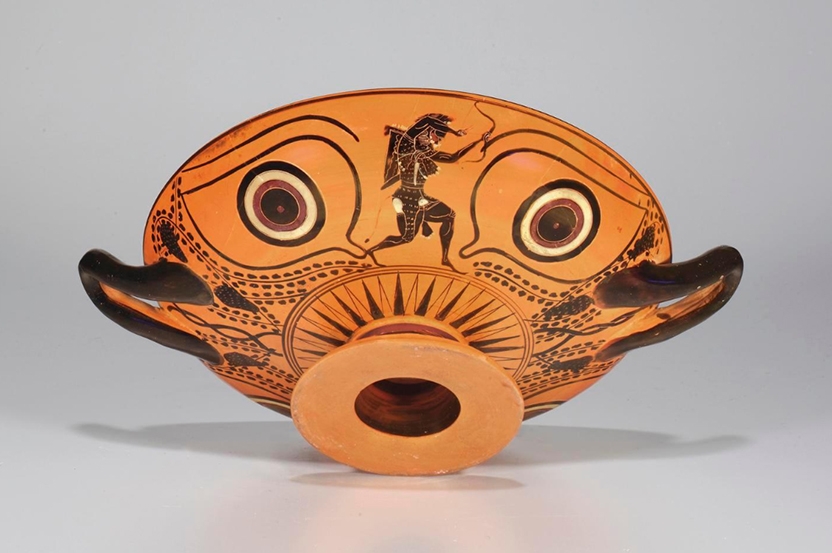
Large eyes on Greek pottery were believed to protect against evil. Depicted on wide, shallow wine goblets such as this, they could also add a touch of humor to social gatherings. When raised to the lips, this cup acts as a mask covering the face of the drinker: the base of the cup resembles a silly snout, while the handles form ears flanking wide eyes. Between these eyes, the Greek hero Heracles pulls his bow. The other side features a dancing maenad—a female follower of Dionysus, the Greek god of wine and revelry (who is also evoked by the tiny grapevines). The “black-figure” vase painting technique, with its strong contrast of black glaze and natural clay, is ideally suited to this vase’s bold juxtaposition of geometric shapes and curved lines.
Black-Figure Neck Amphora Depicting Heracles and Theseus
Attributed to the Circle of the Antimenes Painter (Greek, active c. 530–510 BCE)
Greece, Attica, Archaic period, c. 530–510 BCE
Terracotta
Purchase with funds provided by the Friends of Art Acquisition Fund, the Christian A. Johnson Memorial Art Acquisition Fund, the Walter Cerf Art Fund, and the Memorial Art Fund, 1991.002
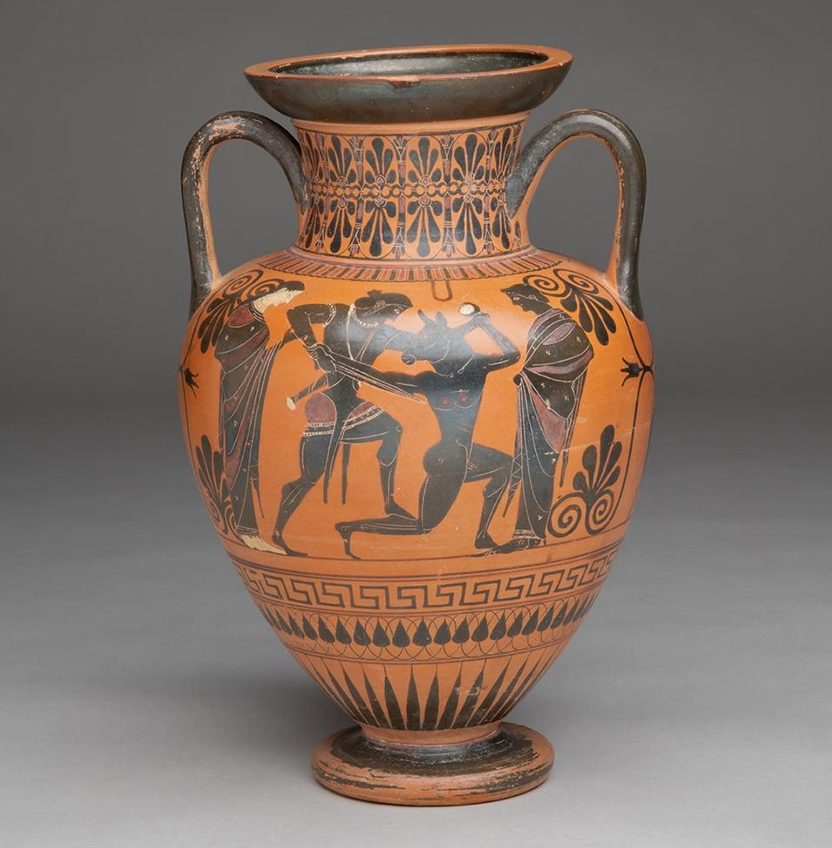
The dramatic scenes decorating this amphora—a wine jug for formal occasions—surely provided lively discussion topics for social gatherings. On the front, Ariadne aids Theseus as he kills the Minotaur; on the back, Heracles battles a foe. The scenes are depicted using the “black-figure” technique, in which figures are rendered in black glaze against a clay background. Although the names of most ancient artists have been lost to history, it is noteworthy that the makers of this vase copied the bold style of one of the most prolific (and widely imitated) Athenian painters, known today only as the Atimenes Painter.
Black-Figure Kalpis Depicting a Four-Horse Chariot
Attributed to the Rycroft Painter (Greek, active c. 510–500 BCE)
Greece, Attica, Archaic period, c. 510–500 BCE
Terracotta
Purchase with funds provided by the Walter Cerf Art Fund, 2005.023
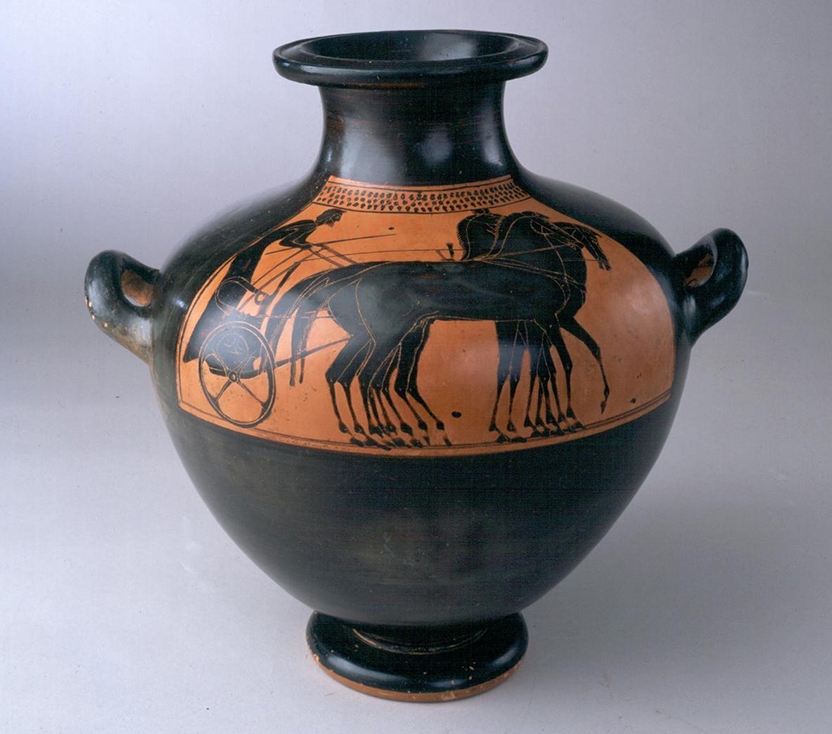
Known today as the Rycroft Painter, the decorator of this water jug incorporated hallmarks of the newly emerging “red-figure” vase painting style into the “black-figure” tradition to suggest the dynamism of a chariot. Using the black-figure technique (in which figures are depicted in black glaze, silhouetted against the clay background), the artist masterfully rendered the rhythmic overlapping of the horses’ legs, evoking the fluid movement characteristic of the newer red-figure technique (in which black glaze surrounds red clay figures, with delicate black lines adding expressive detail). Here, the Roycroft Painter decorated a dramatically curved vase, a new style embraced almost exclusively by red-figure painters.
Red-Figure Neck Amphora (Doubleen) Depicting Nike
Attributed to the Berlin Painter (Greek, active c. 490–460s BCE)
Greece, Attica, Early Classical period, c. 470s BCE
Terracotta
Purchase with funds provided by the Christian A. Johnson Memorial Art Acquisition Fund, 2001.019
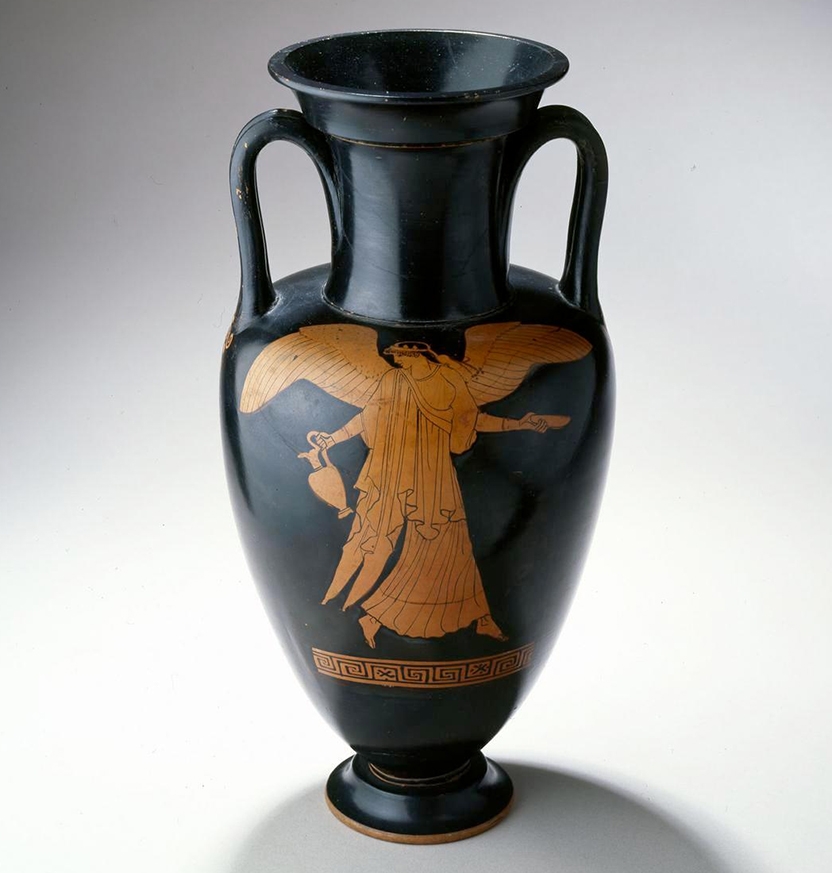
This wine jug depicts Nike, the Greek goddess of victory, speeding toward a celebration. The delicate lines of her flowing drapery enhance the implied movement. This dynamic scene is attributed to an Athenian artist known today as the Berlin Painter (a name coined in the early 20th century by art historian J.D. Beazley after careful study of a vase in a Berlin museum). The Berlin Painter pushed the expressive limits of the recently developed “red-figure technique,” in which black glaze is applied around the contours of figures. As a result, striking “reverse silhouettes” of unglazed clay seem to spring forward from dark backgrounds, further enlivened by delicate details in black glaze.
Red-Figure Column Krater Depicting Theseus and Medea
Attributed to the Naples Painter (Greek, active c. 440–420 BCE)
Greece, High Classical period, c. 440–420 BCE
Terracotta
Purchase with funds provided by the Christian A. Johnson Memorial Art Acquisition Fund, 1998.033
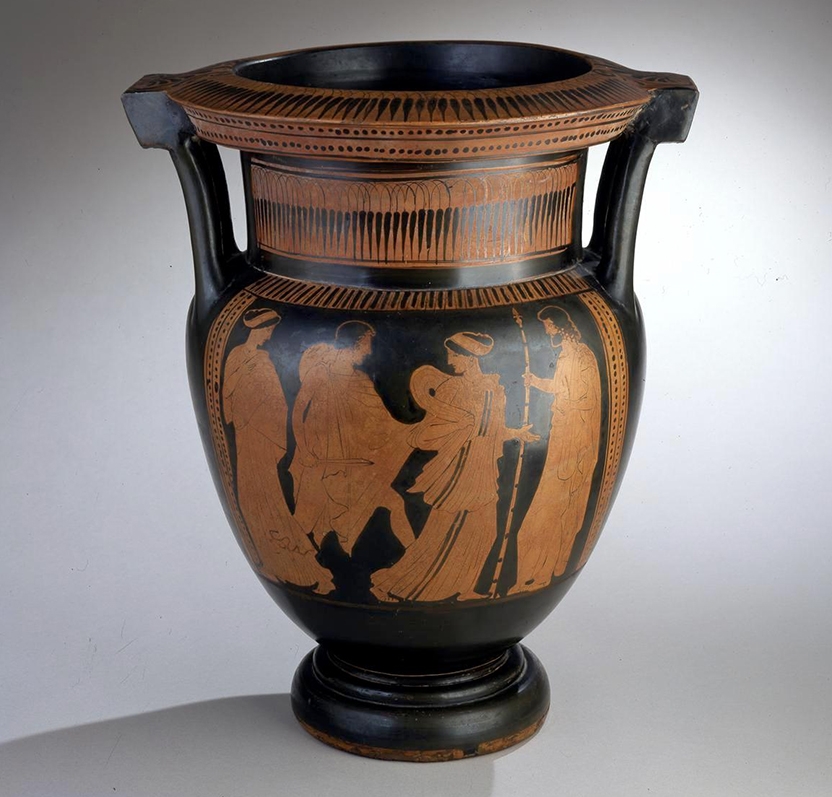
This krater (a vessel used for mixing water into concentrated wine) demonstrates the sensitive expression and dynamic movement made possible by the red-figure technique of vase painting—characterized by fluid black lines animating red clay figures, which seem to emerge from backgrounds of black glaze. On the front of this vase, the energetic poses and flowing robes capture the drama of the confrontation after Medea tried to poison Theseus in order to protect her son’s right to become king. Soon after this vessel was unearthed in the late 1700s, it was reproduced in a widely circulated book that helped spread modern knowledge of developments in ancient Greek vase painting.
Red-Figure Fish Plate
Italy, Greek, Campanian, Late Classical/Early Hellenistic period, c. 350–325 BCE
Terracotta with added white and red
Purchase with funds provided by the Memorial Art Fund, the Fine Arts Acquisition Fund, and the Frederick and Martha Lapham Art Acquisition Fund, 2000.016
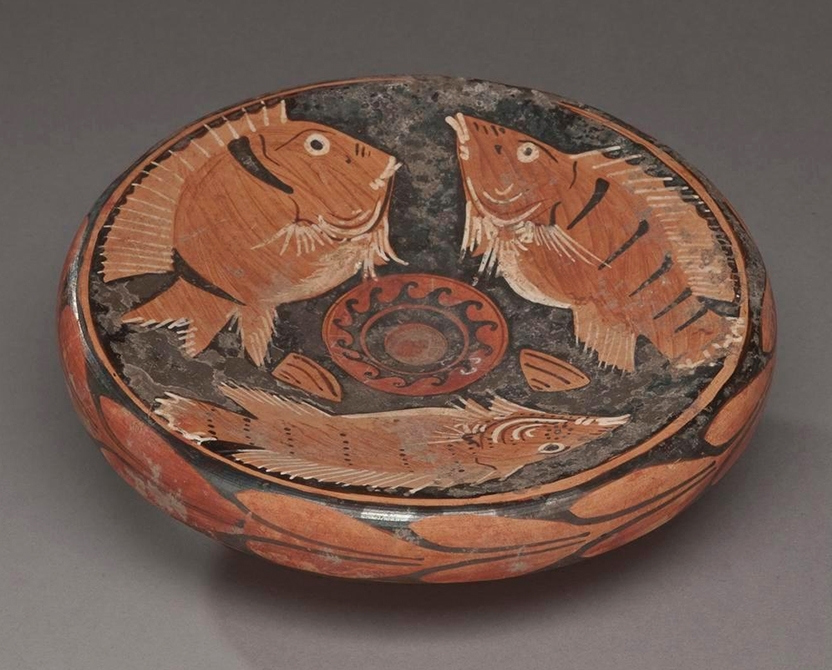
After the 5th century BCE, the Greek colonies in Southern Italy and Sicily became major centers for pottery production. As the population expanded, the market for practical homewares grew and artisans increasingly employed decorative schemes related to everyday life. This saucer depicts fish and clams, attesting to the importance of seafood in the ancient Mediterranean diet. Displayed here alongside ceremonial vessels decorated with warriors and deities, this charming serving plate—with its central depression ideal for holding an aioli dipping sauce—also reminds us of the breadth and variety of ancient society, which produced lofty and mundane objects alike.
